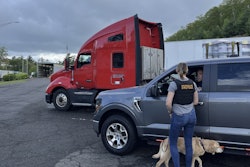Brake linings wear, and when they are worn, you replace them. If that’s all you think a brake job entails, you’re wrong. n Braking a truck requires a long chain of parts that cooperate in pressing that lining evenly against the drum. Every one needs to be regularly inspected or replaced if you want those brakes to work properly. Such care also prevents more costly repairs later, not to mention loss of revenue when inspectors put you out of service, says Rod Russell, product specialist for brake systems and wheel ends at Dana Corp.
“Few people realize the importance that these parts have in brake longevity,” says John Ferry, general manager of TransAxle Corp. of Cinnaminson, N.J., a distributor of remanufactured truck parts.
The secret to long brake life is even application – using the whole lining, not just part of it, to spread the work out. You also need both linings on a wheel to share the load evenly so that one doesn’t wear prematurely and stopping power is maximized.
We all know brake linings wear fast, but the hard parts in the system wear fast, too. There is no way you will get a good brake job unless you inspect everything and throw away anything that isn’t in near-perfect condition. Even when you are doing brakes because of a problem on a single wheel – say, a leaky seal – always replace the same parts on both ends of the axle for the sake of balance. And speaking of seals, you must fix any wheel seal leaks before proceeding with brake work, says Dave Edwards, director of global technology programs at ArvinMeritor. Oily linings won’t stop you.

Technicians should always inspect the worn parts during disassembly, says Larry Gilles of the Tech Team Group at Bendix Commercial Vehicle Systems. Worn parts reveal problems that need to be fixed. If you see a tech just ripping brake parts off and throwing them into a trashcan without examination, go elsewhere.
Shoes. You can’t just re-use shoes, Gilles says. Brake lining applies tightly to the drum only if backed up by the shoe table. Wherever this support is missing because of a gap between lining and table, or uneven because of a rust bulge called rust jacking, you will get a crack. After a set of brakes has gone through two winter seasons, there will be rust and flat spots, as well, because stress distorts the shoe table, Gilles says. This will put uneven heat stress on the lining and crack it. A crack all the way across will put you out of service.
Replace shoes with new ones or have them recoined, a process that flattens the tables with a 750-ton press. This restores just the right arc or curve that will match the arc inside the drum. Gilles cautions against just bending the shoe web back to its original arc because the lining still won’t fit right. Rebuilt shoes must be checked for proper dimensions before being reused, says Prakash Jain, director of braking tech support at ArvinMeritor.
The best rebuilders will often coat the shoe table with a sealer before riveting on the lining, Gilles says. This keeps moisture out and retards rust. Many rebuilders repaint the shoe to retard the process, but whether with paint or sealer, redone shoes should be rust-protected, Jain says.
Linings. If you can upgrade to a long-life design, do so. If you have long-life brakes, replace only with similar parts, Gilles says. The tradeoff for a lower price is often thinner linings, which mean shorter life and more cost per mile.
It’s critical to match friction material to your application, Ferry says. “Every friction manufacturer produces different grades of material to give you the optimum brake performance.” Make sure the lining ratings match the axle ratings, too: for example, a 23,000-pound rating for the wheels of a 46,000-pound tandem axle system.
“I recommend buying from the lining manufacturer,” Gilles says. “A good lining manufacturer will not put his name on a lesser quality lining. Replace with the original equipment lining.”
Watch out when buying because replacement lining does not have to pass the same stopping standards, and the codes for replacements don’t match those for original equipment. Find someone who knows the codes and can replace like with like. Manufacturers such as ArvinMeritor identify the friction material with a specific code, such as R201, which will help you get the exact replacement lining, Jain says.
Shopping for the right lining helps ensure not only long life, but also even wheel-to-wheel brake force. This balance, in turn, ensures stable stops and extends brake life.
Once those assembled shoes are ready, make sure there are no gaps between the linings and tables and that the shoe has been refinished or sealed for rust protection.
Check drum diameter at several locations to make sure the drum is evenly worn and not bell-mouthed.
Drums. Drums must be inspected for heat checking, which are nicks in the surface; bluing, which is a change in color because of heat; significant cracks that reach the edge; and deep ridges cut into the surface by wear where the linings have applied. If the drum surface looks OK and the groove is not too deep, measure the diameter at multiple points with an inside micrometer to make sure wear is even all around. Also, measure across the entire braking surface, from the inside to the outside, to make sure the drum is not bell-mouthed, which will also prevent even lining contact.
Just as the correct arc matters on the shoe table, it matters on the drums. As the drum wears, the arc gets larger. Beyond a certain maximum diameter, the shoe and drum arcs won’t match well enough to stop your truck. Typically, it’s .08 inch over, so a 16.5-inch drum will top out at 16.58 inches. The limit is stamped on the drum.
The .08-inch dimension is important for another reason. The maximum wear limit for any drum is .12 inch, and being under that limit ensures enough life is left in the drum. This limit matters because the drum works like a heat sink, storing the energy during a hard stop. If there is less metal, the drum could get hot too fast and expand, and brake force could fade before you stop.
Although light grooves or ridges can sometimes be removed by machining while leaving enough metal to retain the .08 inch, experts recommend against it. Always replace the drums on both sides of an axle.
Hardware. On every reline, Russell recommends replacing return springs, retaining springs, cam rollers and roller retainers, and anchor pin bushings. Jain adds anchor pins to this list. Russell says they should at least be inspected for looseness or grooving. ArvinMeritor and other suppliers offer these parts in a bag for about $10 a wheel end.
Every one of them is subject to excessive or uneven wear, and replacing them will help you stop and help the new brakes last. For example, return springs play a critical role in backing off the linings fully, Jain says. They normally fatigue by the time a reline is due, and, if they don’t pull the linings all the way back from the drum, the slack adjuster will fail to adjust properly. You’re sure to get dragging brakes – and extreme wear.
Rollers often develop flat spots, especially if a tech has greased the center section designed to roll, not slide, along the S-cam, Gilles says. Some rollers are knurled to provide extra grip on the S-cam, though they should be knurled uniformly, with no flat spots. Make sure standard rollers are smooth and round. Wear on rollers or anchor pin bushings and shoes will put slop into the foundation brake system. Auto slacks don’t compensate for slop. You’ll have excess stroke and low brake force, and, if enough of your brakes are in this condition, you will get put out of service.
Camshafts and bushings. “Always replace brake shoe hardware and cam bushings,” Ferry says. Camshaft bushings must be checked because worn bushings will cock the camshaft, Gilles says. S-cam brakes have a leading and a trailing shoe; worn bushings mean one shoe ends up doing much more work than the other. The camshaft should be firmly forced up and down and the motion measured with a dial indicator. Tolerance is usually .02 inch to .03 inch. If you can feel significant motion, the camshaft bushings should be replaced, Gilles says.
Many trucks come with nylon bushings, which not only don’t last as long as bronze, but will also wear the camshaft bearing journals faster, Gilles says. In highway trucks, nylon is OK, but bronze will last much longer and belongs in all vocational trucks. If replacing the bushings doesn’t get the clearance under control, it means the bearing journals are worn, and you’ll need to replace the camshaft. Also check end play, which can be tightened easily with washers.
Brake spider. The brake spider should be checked for cracks around the boltholes and in the cam and anchor pin areas. Bent spiders are common. What usually makes this happen is the attempt to remove an anchor pin without the proper tool, a small device like a C-clamp. Signs of this problem include shoe contact at different distances from the outside edge or contact between shoes and the drum on its inside, flat surface.
Bent spiders guarantee uneven lining wear. They can even create wheel-bearing and wheel-off problems, because interfering parts make correct bearing adjustment impossible. Replace if damaged.
Slack adjusters. Wheel seals and bearings must be installed and adjusted correctly. The slack adjusters and related hardware also need to be checked before the job is done, Jain says. All the slacks must be properly adjusted after the brakes are reassembled. All must be in good condition and adjusting properly or be rebuilt or replaced. They must be the same, correct size and type for a set of tandems or both sides of a single axle. The chambers, their diaphragms, mountings and pushrods must be in good shape with no diaphragm leakage.
Ask for the stroke figure for every wheel before leaving the shop, and make sure they are all well within Commercial Vehicle Safety Alliance limits for your brake size. Also, road test the truck to ensure it stops forcefully and evenly.
The upper shoe has been properly recoined before assembly, giving good lining-to-drum contact. The lower one simply had new lining installed, giving minimal contact and guaranteed short life. A rig with a number of brakes in this condition can be fatal.
FIND PROS AND LET THEM WORK
“You really have to use someone you trust to do a brake job,” says Paul Hess, service manager at Midway Truck Service, a Western Star dealer in Bethel, Pa. “It helps to ask around and find a place where many truckers have had competent brake work done. ASE certification of technicians is also a good sign.”
Once you’ve found the right place, “Don’t tell the garage how to fix your truck,” Hess says. “Tell them symptoms, not how to fix them.”
“It’s best to establish a personal relationship with a shop you trust,” says Hess’s brother Jim, Midway general manager. “Assuming the shop is in this category, you then get what you pay for.”
“That means you shouldn’t bellyache about the number of items on the bill,” Paul Hess adds. A good brake job lasts a lot longer than a cheap one.









